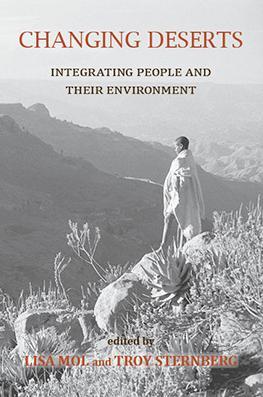Mol, Lisa, and Troy Sternberg, eds. Changing Deserts: Integrating People and Their Environment. Cambridge: The White Horse Press, 2012.
Deserts—vast, empty places where time appears to stand still. The very word conjures images of endless seas of sand, blistering heat, and a virtual absence of life. However, deserts encompass a large variety of landscapes and life beyond our stereotypes. As well as magnificent Saharan dunes under a blazing sun, the desert concept encompasses the intensely cold winters of the Gobi, the snow-covered expanse of Antarctica, and the rock-strewn drylands of Pakistan. Deserts are environments in perpetual flux and home to peoples as diverse as their surroundings, peoples who grapple with a broad spectrum of cultural, political, and environmental issues as they wrest livelihoods from marginal lands.
The cultures, environments, and histories of deserts, while fundamentally entangled, are rarely studied as part of a network. To bring different disciplines together, the first Oxford Interdisciplinary Deserts Conference in March 2010 assembled a wide range of researchers from backgrounds as varied as physics, history, archaeology, anthropology, geology, and geography. This volume draws on the diversity of papers presented to give an overview of current research in deserts and drylands. Readers are invited to explore the wide range of desert environments and peoples, and the ever-evolving challenges they face.
Lisa Mol is a research associate at the School of Geography and the Environment, Oxford University. She is a stone weathering geomorphologist and has conducted research on the weathering of Rock Art in South Africa. She currently researches the effect of armed warfare on fragile immovable heritage in Eastern Europe, and the Middle East.
Troy Sternberg is a researcher at the School of Geography, Oxford University. His research focus is on natural hazards, environmental processes, the effectiveness of traditional nomadic strategies, and the comparative ecological impact of livelihoods across the Asian steppe. His interest in Mongolia concerns developing rural water access, quantifying drought and degradation, and placing Mongolian pastoralism and the Gobi environment in a broader global context.
All rights reserved. © 2011 The White Horse Press. Distributed by Turpin Distribution

This work is licensed under a Creative Commons Attribution-NonCommercial-NoDerivatives 4.0 International License.


